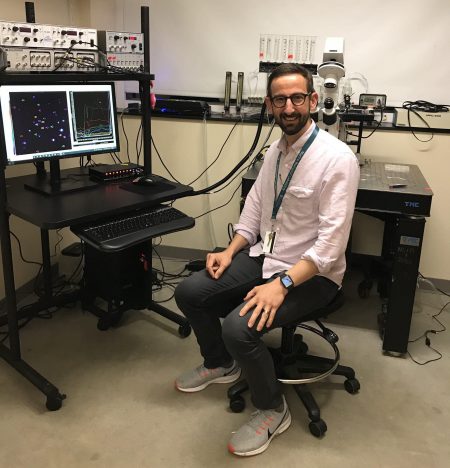Advancing Research to Treat Pain
Aug 17, 2021
Interviews in this blog are by Dr. Tonya Palermo
Professor, UW Department of Anesthesiology & Pain Medicine
One of UW Medicine’s priorities is promoting research and collaboration across the entire health system and UW departments, with the critical support of philanthropy. An example of this collaborative spirit is the Scan Design Foundation Research Innovation Awards, which provide research grants for creative, early-stage research projects in the area of pain medicine.
Scan Design Foundation has supported research with the potential for breakthroughs in the treatment of pain being done by UW Medicine and University of Washington researchers since 2005. The latest round of grants is supporting three efforts that span mitigating opiate withdrawal with cannabinoid compounds, understanding how skin cells contribute to pain and developing treatments for patients with peripheral neuropathies.
Here, the three principal investigators and award recipients share about their projects, themselves, and how grant funding and philanthropy are critical to their work.

David J. Marcus, PhD
Postdoctoral Fellow, Anesthesiology and Pain Medicine, UW Medicine
Principal Investigator, Laboratory of Michael Bruchas
Can you describe your project?
David Marcus: Over the last two decades, there has been a dramatic rise in opiate overdose deaths in the United States. Despite this growing problem, few new therapeutic options for the treatment of opiate dependence have been developed. Recently, cannabinoid compounds such as THC, the primary psychoactive constituent of marijuana, have been demonstrated to ameliorate the dysphoric effects of opiate dependence and withdrawal. My proposed research will investigate a neural circuit that mediates opiate withdrawal symptoms, and how cannabinoid compounds may interact with this circuit to mitigate the adverse effects of opiate withdrawal.
What difference could breakthroughs in this area mean for people seeking care?
David Marcus: Currently, no cannabinoid compounds have been approved for the treatment of opioid use disorder. This is in part due to a lack of strong scientific evidence demonstrating how cannabinoids can ameliorate the negative effects of opioid withdrawal. Our proposed study aims to uncover the precise neural mechanism by which cannabinoids elicit this therapeutic effect. This will add to a growing body of literature regarding the use of cannabinoids for the treatment of opioid use disorder, with the long-term goal of spurring cannabinoid-based drug development and FDA approval of cannabinoid compounds for the treatment of opioid use disorder.
What first got you interested in the field of pain medicine?
David Marcus: My very first project as an undergraduate researcher was investigating the mechanisms of cannabinoid-induced pain alleviation. This project soon expanded to examine the mechanisms that drive tolerance to opioid pain medications such as morphine and fentanyl. These projects instilled a lifelong passion to understand the neural underpinnings of medicines used to relieve pain, and how we can develop better therapeutics to mitigate tolerance and withdrawal to commonly used pain opioid pain medications.
What are your career goals — what’s next for you?
David Marcus: My overarching career goal is to run an independent research lab at an academic institution. I am currently in my second year of postdoctoral training at UW, and I am beginning to construct a vision and direction for my own independent research. The funding I will receive from the Scan Design Foundation Research Innovation Awards will provide a pivotal step toward this independence and will lay the framework for the future direction of my lab.
How does grant funding and philanthropy impact your work?
David Marcus: All research labs at academic institutions rely on grant funding and philanthropic contributions to support their research. I fully understand that if I want to achieve independence, I will need to be adept in securing my own funding. I hope that the research I conduct with the funds provided by the Scan Design Foundation will help generate critical preliminary data for future grant applications that will support my transition to independence.

Jay Z. Parrish, PhD
Associate Professor of Biology, University of Washington
Principal Investigator, The Parrish Lab
Weill Neurohub Investigator
Can you describe your project?
Jay Parrish: We aim to understand the contributions of skin cells to pain. Our skin provides a durable, waterproof barrier to environmental insults and is innervated by somatosensory neurons that shape our experience of the world, allowing for perception and discrimination of pain, touch, pressure and movement. Among these, pain is of particular interest, both because of its adverse influence on quality of life and because of the highly subjective nature of pain. Recent studies suggest that skin cells can act as primary sensors of noxious stimuli and can directly modulate somatosensory neuron activity. But mechanisms of sensory detection and neuronal modulation by epidermal cells are largely unknown. The molecular building blocks for nociception are highly conserved throughout evolution; therefore, my lab exploits the genetically tractable fruit fly Drosophila to identify epidermal responses to noxious stimuli and epidermal signals that influence nociceptive (pain-sensing) neuron function.
What difference could breakthroughs in this area mean for people seeking care?
Jay Parrish: Epidermal cells provide the first point of contact for sensory stimuli, but the molecular mechanisms by which epidermal cells respond to noxious stimuli are largely unknown. This gap in our knowledge is particularly significant given the prevalence of pathological skin conditions associated with debilitating pain. As a result, epidermal cells represent a largely underdeveloped target for pain therapeutics. Drugs targeting opioid receptors are still a primary therapeutic option for intractable pain. This is in spite of opioid drugs’ high potential for abuse, the increasing prevalence of opioid addiction, and numerous side effects due to opioids’ multiple sites of action in the central nervous system. Thus, we propose that unraveling peripheral sensory mechanisms of pain will address an urgent medical need to identify new pain targets.

What first got you interested in the field of pain medicine?
Jay Parrish: For more than 20 years my research has focused on development of somatosensory neurons, beginning with graduate work on control of cell death in these neurons. In my postdoctoral studies, I explored mechanisms of growth control in somatosensory neurons, with a particular focus on how sensory neuron growth is coordinated with skin expansion during organism growth. These studies spurred an interest in skin cell biology, and early work in my lab identified specialized terminal structures in which skin cells physically enclose pain-sensing neurons. This anatomical coupling of skin cells and pain-sensing neurons led us to explore active roles for skin cells in sensing and responding to noxious stimuli. To test this hypothesis, we engineered a strain of fruit flies in which skin cells could be stimulated with light stimulus that is normally innocuous to flies. Remarkably, stimulating these light-responsive skin cells elicited nociceptive behavior output in flies, demonstrating that skin cells can directly activate pain-sensing neurons in flies. Our current studies in the lab build on these exciting observations.
What are your career goals — what’s next for you?
Jay Parrish: My long-term goal is to understand how environmental signals shape somatosensory neuron structure and function, using the fruit fly Drosophila melanogaster as an engine for discovery. Currently, our studies focus on the roles that non-neuronal cells in the periphery, most notably epidermal cells in the skin, play in shaping sensory transduction. We recently began a new collaboration using primary human keratinocytes and pre-clinical mouse models of acute and chronic pain to determine whether findings from our fly studies identify evolutionarily conserved epidermal mechanisms of pain transduction.
How does grant funding and philanthropy impact your work?
Jay Parrish: Our research program depends entirely on extramural funding, which provides the support necessary for both laboratory staff and daily laboratory operations. While there are a variety of large funding agencies that support biomedical research (NIH, for example), funding awards that support the work required to cultivate new projects, in particular to support “proof-of-concept” studies of new ideas, are rare. The Scan Design award fills this gap, providing us with the support we need to develop an exciting new idea into a project that will be competitive for federal funding.

Jia Zhu, PhD
Associate Professor, Laboratory Medicine and Pathology, UW Medicine
Can you describe your project?
Jia Zhu: Peripheral neuropathies and associated pain are peripheral nerve diseases that affect nearly 20 million people in the United States. Human herpes simplex virus (HSV) is a neurotrophic virus causing lifelong latent infection in sensory neurons with intermittent recurrence in skin and mucosa, but rarely neuropathy. Studies indicate that cytokine IL-17c might depict a natural pathway explored by HSV to orchestrate peripheral nerve repair and regeneration process. This project aims to determine the cellular target and signaling pathway of IL-17c in peripheral nerve repairment in the human system.
What difference could breakthroughs in this area mean for people seeking care?
Jia Zhu: Peripheral neuropathy is both a complication and rate limiter for many forms of cancer chemotherapy and is a substantive complication of long-term diabetes and Herpes Zoster infections. It represents one of the most common neurological disorders without an effective treatment. Our study relies on deciphering the human body’s naturally occurring nerve repair mechanism, which silently operates during a lifelong viral infection of sensory neurons. Outcomes of our research might open up new therapeutic avenues to combat this disease.
What first got you interested in the field of pain?
Jia Zhu: Herpes simplex virus is a fascinating pathogen to study, largely due to its ability to establish latent infection in the sensory nervous system. Stress and other conditions causing continual viral reactivation; however, sensory anesthesia or neuropathic pain are extremely rare. Why does peripheral nerve damage not occur despite frequent HSV reactivation in humans? This question has occupied my mind for a long time.
What are your career goals – what’s next for you?
Jia Zhu: Peripheral nerves have significant capacity for regeneration after injuries. Our overarching objective is to decipher tissue-based nerve regeneration mechanisms to develop novel therapeutic agents for treating patients with peripheral neuropathies and associated pain. My goal through this grant support is to generate critical preliminary data and testable hypothesis to apply for R01-level federal funding and to engage biopharmaceutical companies for their expertise in drug development.
How does grant funding and philanthropy impact your work?
Jia Zhu: Biomedical research relies on all sources of grant funding. Both federal and philanthropic contributions are essential to propel technologic innovation and scientific advancement, but support from philanthropy is particularly important. It provides us the opportunity for early-stage data generation and hypothesis testing. I really appreciate the generosity of Scan Design Foundation and the possibility it brings to the field of pain research.
Accelerate Pain Research: You can keep this breakthrough research in pain medicine going with a gift to the Scan Design Foundation Research Innovation Award fund.
